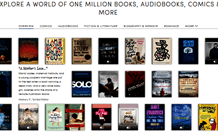 While content will always be important to subscription services, we can’t ignore the importance of reading environment. The greatest content in an unusable app won’t attract many subscribers.
While content will always be important to subscription services, we can’t ignore the importance of reading environment. The greatest content in an unusable app won’t attract many subscribers.
Both Oyster and Scribd recently released app updates, and while they took different approaches, both were significant for users.
Oyster added annotation and sharing features to their app. (Hat tip to Nate at Digital Reader for covering it.) While those aren’t features I care about, I know lots of readers love the ability to highlight and share passages. Sharing of highlights is also good passive marketing for Oyster. I assume the shares mention Oyster in some way, so it’s free advertising for them anytime someone shares to Facebook or Twitter. And even if Oyster isn’t mentioned, it’s logical to assume someone will ask “hey, where’d you find that?” which does much the same thing.
Scribd took an approach that was much closer to my heart. They implemented the new KitKat immersive mode. If you don’t have one of the tiny percentages of devices that’s been updated, you can check out this article to see what it looks like.
Immersive mode basically uses the entire screen, including the band at the top and bottom which are used for virtual menu buttons and status. Once you’ve used it, it’s hard to go back. Not all apps support it yet. As far as I know, only Play Books, Scribd, Moon+ Reader and FBReader support it, so adding it is a big deal. From reading reviews of other apps (like Kindle and Mantano), users expect it to be supported.
The other significant Scribd update wasn’t even mentioned in their Changelog. They used to use locations, similar to Kindle, and there was no way to view time until end of chapter. Now they’ve switched to page numbers (which do appear to be arbitrary, based on font size and screen rotation), but they are easier to use than locations. And they’ve added a tiny “pages until end of chapter” at the bottom of the screen. That’s one of my favorite features in apps that have it.
So good job to both companies for the continuous improvement to their apps to improve the reader experience. Both still have a long way to go to match fuller-featured apps, but they are moving in the right direction. It appears as if they are listening to their users and trying to keep them happy.
Now if one of them can just crack implementation on ereaders (instead of just tablets and tablet-like readers). That would be a huge competitive advantage.


































“Both still have a long way to go to match fuller-featured apps, but they are moving in the right direction. It appears as if they are listening to their users and trying to keep them happy.” –
gotta agree; and it’s good to see that they each care enough about their platform to continue improving for their respective reading experiences –
both also seem to be gaining large chunks of other published work from where they started, and so content also continues to improve
all in all, kind of exciting, we’ll see what the future continues to bring with this new reading model 😉
So glad you like the changes on Scribd, Juli! Carrie from Scribd here again.
I love the new “xx pages left in this chapter” feature. It lets me know when I can finish the chapter and go to bed when I read at night. 😉